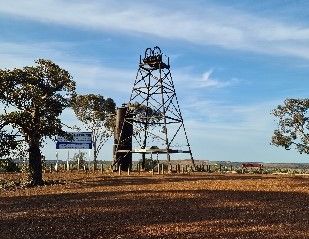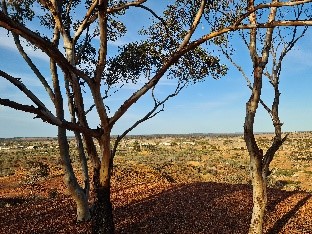Shire of Coolgardie Attractions
Warden Finnerty’s Residence
Warden Finnerty's Residence is one of the early buildings built by the Bunnings brothers, who's hardware company went on to be one of Australia's largest retail chains. A beautiful old house built of local stone in 1895 for Coolgardie's first Resident Magistrate and Mining Warden, John Michael Finnerty. During a visit here you can walk through the rooms, with lovely antique furnishings and chinaware on display, to capture the feeling of life in the late 1890's.
While visiting, enjoy a Devonshire Tea while taking in the view from the veranda of this picturesque house.
Open Saturday – Wednesday 11am – 4pm
Closed Thursday – Friday
Group bookings welcome, contact Coolgardie Visitors Centre 08 9026 6090 for bookings and enquiries
Varischetti Mine Rescue
Situated 1km down the track from Bonnevaile is the site of the famous 1907 Varschetti Mine Rescue.
In the early evening of March 28, 1907, a miner, Modesto Varischetti was brought to the surface after having been entombed under water in a mine at Bonnievale for 10 days.
Widgiemooltha - Nullarbor Golf Links
Play the world’s longest golf course consisting of 19 – holes(par 72) spanning 1,365 kilometres along the Eyre Highway from Kalgoorlie in WA to Ceduna in SA.
Enjoy two holes in the Shire of Coolgardie, Kambalda’s “Silver Lake” Par 4 hole and Wigiemoothla’s “Golden Eagle” Par 3 hole.
Golden Eagle
The largest gold nugget ever discovered in WA was found at Larkinville Mine by 16 year old Jim Lacombe on 15th January 1932. Named the Golden Eagle, it weighed in at a massive 1,135 oz.
Stop in at Widgiemooltha and see the Golden Eagle replica which is surrounded by a roadhouse, tavern and a motel/caravan park.
Kambalda Pioneer Cemetery
Initially known as the Red Hill Cemetery until the name Kambalda was gazetted in 1897. This small pioneer cemetery has five individual graves, however a mystery surrounds this cemetery as two of the graves belong to one person.
Coolgardie 'Old' Cemetery
What is now referred to as the old or pioneer cemetery was used until November 1894. It proved very difficult to conduct burials there due to the nature of the soil – rock hard! Of the approximately 30 people buried, the names of only three are known.
Coolgardie 'New' Cemetery
The ‘new’ cemetery was commissioned in November 1894 and the first burial took place that month. From then on burials were occurring almost daily. With the typhoid epidemics of the 1890s it was said that half the town was kept busy burying the other half. There are more than 3000 graves and of these 25 per cent contain a child five years of age or under. Spare a thought for the 200 nameless infants buried here, many in unmarked graves.
Lions Lookout
Lion’s Lookout is the view Arthur Bayley and William Ford had when they first arrived in the area and discovered gold. The lookout offers panoramic views to the east of the town. It is also where the original head frame from the famous “Bailey’s Reward” gold mine is re-erected.


Ben Prior Park
Ben Prior Park is a free open-air museum named from its founder Mr Benjamin Austin Prior. Ben came to Coolgardie with his wife and five children in 1932, liked what he saw and two years later set up his garage (next to the park).
The park contains statues built by Ben himself, along with the wagons that bought the Sisters of Mercy Nurses to Coolgardie during the Typhoid epidemic situated among the many items relating to the gold mining history of the town and many of the pieces Ben found out bush while prospecting.
Open 7 days 9.00 am - 4.30 pm
Coolgardie Historic Railway Station
The Coolgardie Railway Station was opened on March 23rd, 1896. Traffic in the early period included a train each way, each day to and from Perth, and was one of the busiest stations in the state.
The building itself is made of stone and brick with a ribbed iron roof, similar in design and detail to other railway stations of the period in the state. The last passenger train to pass through Coolgardie was the evening express from Kalgoorlie to Perth on November 28th, 1971 and was farewelled by local citizens. After its life as a train station, it was run as a museum but is now closed. It is still a beautiful building with a locomotive on the tracks to view.
Coolgardie Cemetery
Much of Coolgardie's fascinating history can be read on the headstones of the Pioneer Cemetery used between 1892-1894, and the Coolgardie Cemetery which is still in use today. As typhoid raced through the town in the early goldrush days, many people died without their identity being recorded. There are famous people including explorer Ernest Giles, Bertha Finnerty and Tagh Mahomed buried here along side the unknown. The grave of our better known ghost, Elizabeth Gold, can be found at the Coolgardie Cemetery, buried near the resting place of her murderer.
Coolgardie Gorge
Just to the south east of Coolgardie along the Coolgardie-Esperance Highway, the Gorge was once an important water source to the local population prior to the completion of the ‘Golden Pipeline’. It is now a spot to enjoy a picnic under a shady gum tree, watch the sunset or possibly spot some birds or other wildlife coming in for a drink.
Coolgardie Bluff Walk Trail
On the north-east of the Coolgardie townsite, the Bluff Walk Trail includes heritage signage and explains the cultural significance of the area to the local Indigenous people. With iron sculptures to see and beautiful look out points along the way, this trail is also a dog friendly space.
Gnarlbine Soak
Located 23km south of Coolgardie on Victoria Rock Road, Gnarlbine Soak was originally an Aboriginal waterhole. Explorer HM Lefroy made the discovery of this important water source for pioneers and prospectors in 1863, it was given its name in 1865 by CC Hunt.
Kunanalling
At Kunanalling you will find the ruins of the hotel that once housed 800 prospectors at a time. All that remains of the stone hotel are its ruins and its three prominent chimneys. Situated 32 km north of Coolgardie on Coolgardie North Road.
Boondi Rock
An achievement in pioneer ingenuity, this beautiful water catchment area shows a fragment of the early transport system.
Found in the Greater Western Woodlands, Boondi Rock was a water catchment area for the steam trains. Slabs of granite were moved from a quarry and used to funnel the rainwater to the dam that serviced the steam trains of the era.
Lake Lefroy
This expansive 512km ethereal salt lake is part of an ancient river system that once wove its way through the Goldfields. Being such a large smooth surface makes Lake Lefroy perfect for land sailing and has led to this being a site for Australian land speed record attempts and in 2007 Lake Lefroy hosted the Pacrim Land Sailing event attracting visitors from all over the world.